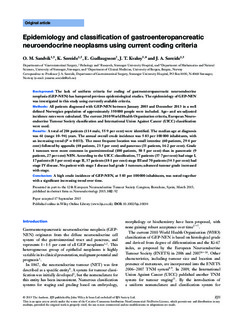| dc.contributor.author | Sandvik, Oddvar Mathias | |
| dc.contributor.author | Søreide, Kjetil | |
| dc.contributor.author | Gudlaugsson, Einar | |
| dc.contributor.author | Kvaløy, Jan Terje | |
| dc.contributor.author | Søreide, Jon Arne | |
| dc.date.accessioned | 2016-02-04T12:16:57Z | |
| dc.date.accessioned | 2016-03-09T14:44:00Z | |
| dc.date.available | 2016-02-04T12:16:57Z | |
| dc.date.available | 2016-03-09T14:44:00Z | |
| dc.date.issued | 2015-09 | |
| dc.identifier.citation | Sandvik, O.M. et al. (2015) Epidemiology and classification of gastroenteropancreatic neuroendocrine neoplasms using current coding criteria Epidemiology and classification of gastroenteropancreatic neuroendocrine neoplasms using current coding criteria. British Journal of Surgery 2015, 103(3), pp. 226-232 | nb_NO |
| dc.identifier.issn | 1365-2168 | |
| dc.identifier.uri | http://hdl.handle.net/11250/2381892 | |
| dc.description | BJS published by John Wiley & Sons Ltd on behalf of BJS Society Ltd.
This is an open access article under the terms of the Creative Commons Attribution-NonCommercial-NoDerivs License, which permits use and distribution in any medium, provided the original work is properly cited, the use is non-commercial and no modifications or adaptations are made. | nb_NO |
| dc.description.abstract | Background:
The lack of uniform criteria for coding of gastroenteropancreatic neuroendocrine
neoplasia (GEP-NEN) has hampered previous epidemiological studies. The epidemiology of GEP-NEN
was investigated in this study using currently available criteria.
Methods:
All patients diagnosed with GEP-NEN between January 2003 and December 2013 in a well
defined Norwegian population of approximately 350000 people were included. Age- and sex-adjusted
incidence rates were calculated. The current 2010 World Health Organization criteria, European Neuro-
endocrine Tumour Society classification and International Union Against Cancer (UICC) classification
were used.
Results:
A total of 204 patients (114 male, 55
⋅
9 per cent) were identified. The median age at diagnosis
was 61 (range 10–94) years. The annual overall crude incidence was 5⋅83 per 100000 inhabitants, with
an increasing trend (P=0⋅033). The most frequent location was small intestine (60 patients, 29⋅4 per
cent) followed by appendix (48 patients, 23⋅5 per cent) and pancreas (33 patients, 16⋅2 per cent). Grade
1 tumours were more common in gastrointestinal (100 patients, 58⋅5 per cent) than in pancreatic (9
patients, 27 per cent) NEN. According to the UICC classification, 77 patients (37⋅7 per cent) had stage I,
17 patients (8⋅3 per cent) stage II, 37 patients (18⋅1 per cent) stage III and 70 patients (34⋅3 per cent) had
stage IV disease. No patient with stage I disease had grade 3 tumours; advanced tumour grade increased
with stage.
Conclusion:
A high crude incidence of GEP-NEN, at 5⋅83 per 100000 inhabitants, was noted together
with a significant increasing trend over time, | nb_NO |
| dc.language.iso | eng | nb_NO |
| dc.rights | Navngivelse-Ikkekommersiell-IngenBearbeidelse 3.0 Norge | * |
| dc.rights.uri | http://creativecommons.org/licenses/by-nc-nd/3.0/no/ | * |
| dc.subject | kreft | nb_NO |
| dc.subject | gastroenteropancreatic neuroendocrine neoplasia | nb_NO |
| dc.subject | GEP-NEN | nb_NO |
| dc.subject | epidemiologi | nb_NO |
| dc.title | Epidemiology and classification of gastroenteropancreatic neuroendocrine neoplasms using current coding criteria | nb_NO |
| dc.type | Journal article | nb_NO |
| dc.type | Peer reviewed | nb_NO |
| dc.date.updated | 2016-02-04T12:16:57Z | |
| dc.rights.holder | © 2015 The Authors. | nb_NO |
| dc.subject.nsi | VDP::Medical disciplines: 700 | nb_NO |
| dc.source.pagenumber | 226-232 | nb_NO |
| dc.source.volume | 103 | nb_NO |
| dc.source.journal | British Journal of Surgery | nb_NO |
| dc.source.issue | 3 | nb_NO |
| dc.identifier.doi | 10.1002/bjs.10034 | |
| dc.identifier.cristin | 1323884 | |

